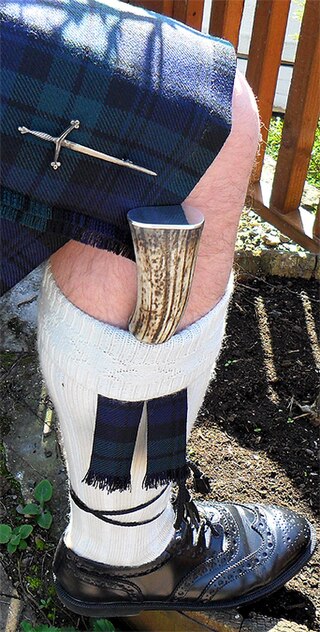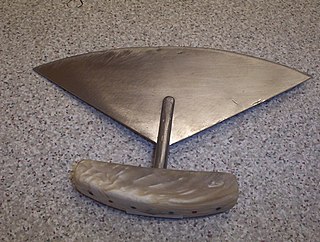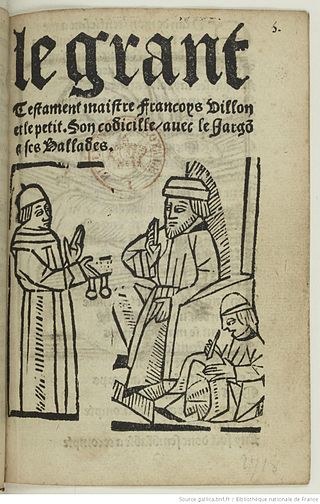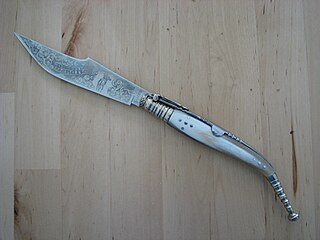
A knife is a tool or weapon with a cutting edge or blade, usually attached to a handle or hilt. One of the earliest tools used by humanity, knives appeared at least 2.5 million years ago, as evidenced by the Oldowan tools. Originally made of wood, bone, and stone, over the centuries, in step with improvements in both metallurgy and manufacturing, knife blades have been made from copper, bronze, iron, steel, ceramic, and titanium. Most modern knives have either fixed or folding blades; blade patterns and styles vary by maker and country of origin.
Polari is a form of slang or cant used in Britain by some actors, circus and fairground showmen, professional wrestlers, merchant navy sailors, criminals, sex workers, and, particularly, the gay subculture. There is some debate about its origins, but it can be traced to at least the 19th century and possibly as early as the 16th century. There is a long-standing connection with Punch and Judy street puppet performers, who traditionally used Polari to converse.
Shelta is a language spoken by Mincéirí, particularly in Ireland and the United Kingdom. It is widely known as the Cant, to its native speakers in Ireland as de Gammon or Tarri, and to the linguistic community as Shelta; other terms for it include the Seldru, and Shelta Thari, among others. The exact number of native speakers is hard to determine due to sociolinguistic issues but Ethnologue puts the number of speakers at 30,000 in the UK, 6,000 in Ireland, and 50,000 in the US. The figure for at least the UK is dated to 1990; it is not clear if the other figures are from the same source.

A Bowie knife is a pattern of fixed-blade fighting knife created by Rezin Bowie in the early 19th century for his brother James Bowie, who had become famous for his use of a large knife at a duel known as the Sandbar Fight.

A switchblade is a pocketknife with a sliding or pivoting blade contained in the handle which is extended automatically by a spring when a button, lever, or switch on the handle or bolster is activated. Virtually all switchblades incorporate a locking blade, where the blade is locked against accidental closure when the blade is in the open position. It is unlocked by a mechanism that allows the blade to be folded and locked in the closed position.
A cant is the jargon or language of a group, often employed to exclude or mislead people outside the group. It may also be called a cryptolect, argot, pseudo-language, anti-language or secret language. Each term differs slightly in meaning; their uses are inconsistent. Richard Rorty defines cant by saying that "'Cant', in the sense in which Samuel Johnson exclaims, 'Clear your mind of cant,' means, in other words, something like that which 'people usually say without thinking, the standard thing to say, what one normally says'." In Heideggerian terms it is what "das Man" says.

A balisong, also known as a butterfly knife, fan knife or Batangas knife, is a type of folding pocketknife that originated in the Philippines. Its distinct features are two handles counter-rotating around the tang such that, when closed, the blade is concealed within grooves in the handles. A latch sometimes holds the handles together; typically mounted on the one facing the cutting edge.

The sgian-dubh – also anglicized as skene-dhu – is a small, single-edged knife worn as part of traditional Scottish Highland dress. Originally used for eating and preparing fruit, meat, and cutting bread and cheese, as well as serving for other more general day-to-day uses such as cutting material and protection, it is now worn as part of traditional Scottish dress tucked into the top of the kilt hose with only the upper portion of the hilt visible. The sgian-dubh is normally worn on the same side as the dominant hand.
A gravity knife is a knife with a blade contained in its handle, and that opens its blade through the force of gravity. This mechanism of opening is fundamentally different from the switchblade, which extends its spring-propelled blade automatically upon the push of a button, switch, or fulcrum lever. The main purpose of gravity opening is that it allows opening and closing to be done one handed, in situations where the other hand is occupied. Hence, historically they have been issued to parachutists to cut off caught lines, such as lines tangled in trees, a major potential use of the gravity knife.

A ballistic knife is a knife with a detachable blade that can be ejected to a distance of several meters/yards by pressing a trigger or operating a lever or switch on the handle. Spring-powered ballistic knives first appeared in books and press reports on Soviet and Eastern Bloc armed forces in the late 1970s. Commercially-produced ballistic knives briefly gained notoriety in the United States in the mid-1980s after they were marketed and sold in the United States and other Western countries. Since then, the marketing and sale of ballistic knives to civilians has been restricted or prohibited by law in several nations.

A swordstick or cane-sword is a cane containing a hidden blade or sword. The term is typically used to describe European weapons from around the 18th century. But similar devices have been used throughout history, notably the Roman dolon, the Japanese shikomizue and the Indian gupti.

An ulu is an all-purpose knife traditionally used by Inuit, Iñupiat, Yupik, and Aleut women. It is used in applications as diverse as skinning and cleaning animals, cutting a child's hair, cutting food, and sometimes even trimming blocks of snow and ice used to build an igloo.

Thieves' cant is a cant, cryptolect, or argot which was formerly used by thieves, beggars, and hustlers of various kinds in Great Britain and to a lesser extent in other English-speaking countries. It is now mostly obsolete and used in literature and fantasy role-playing, although individual terms continue to be used in the criminal subcultures of Britain and the United States.

A push dagger is a short-bladed dagger with a "T" handle designed to be grasped and held in a closed-fist hand so that the blade protrudes from the front of the fist, either between the index and middle fingers or between the two central fingers, when the grip and blade are symmetrical.

Prison slang is an argot used primarily by criminals and detainees in correctional institutions. It is a form of anti-language. Many of the terms deal with criminal behavior, incarcerated life, legal cases, street life, and different types of inmates. Prison slang varies depending on institution, region, and country. Prison slang can be found in other written forms such as diaries, letters, tattoos, ballads, songs, and poems. Prison slang has existed as long as there have been crime and prisons; in Charles Dickens' time it was known as "thieves' cant". Words from prison slang often eventually migrate into common usage, such as "snitch", "ducking", and "narc". Terms can also lose meaning or become obsolete such as "slammer" and "bull-derm."

The navaja is a traditional Spanish folding-blade fighting and utility knife.
Knife legislation is defined as the body of statutory law or case law promulgated or enacted by a government or other governing jurisdiction that prohibits, criminalizes, or restricts the otherwise legal manufacture, importation, sale, transfer, possession, transport, or use of knives.
An offensive weapon is a tool made, adapted or intended for the purpose of inflicting physical injury upon another person.

Prison violence is a daily occurrence due to the diversity of inmates with varied criminal backgrounds in penitentiaries. The three different types of attacks are inmate on inmate, inmate on guard, and self-inflicted. These attacks can either be impulsive and spontaneous or well-planned out and premeditated. Factors such as gang rivalries, overcrowding, minor disputes, and prison design contribute to violent attacks. Prisons are trying to avoid, or at least better deal with these situations by being proactive. They are taking steps like placing violent convicts and gang leaders into solitary confinement, balancing the cells by critically examining each inmate to see where they are likely to reside peacefully, reducing blind spots, and training as well as educating the officers.














